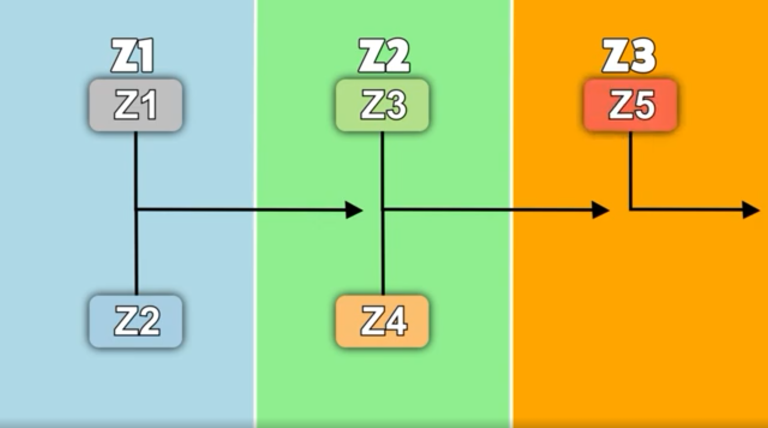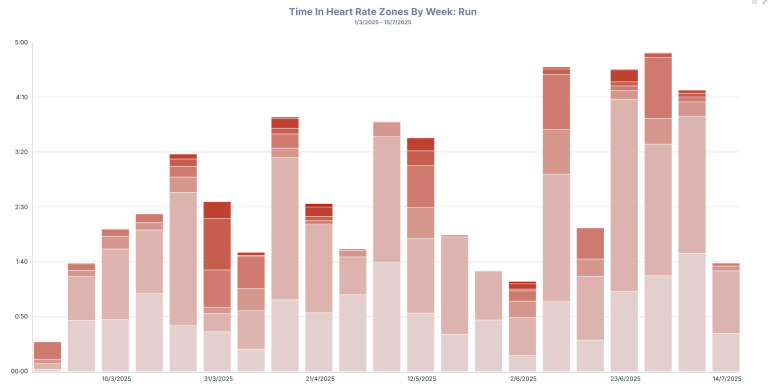Zone 2. It is all the rage. It is probably the most overused term in the history of endurance sports. Unfortunately, a lot of the people that throw the term around have a limited understanding of exactly what it is, what it does, and how much of it they really need to do.
But do not worry. In this post, I am going to explain exactly these things. You will know why you need to do it and how big of a piece of the training puzzle it truly is. Also, this information is based on a variety of research studies, not just a single one by someone trying to be different. I am here to give you the best information so you can inform your training to be as efficient as possible.
Before we dive in, I want to clarify that I am talking about Zone 2 in the 5-zone training model. This is the default model you find on your Garmin and most other fitness devices. This zone can also sometimes be called “Easy” or “Endurance”.
So, What Is Zone 2?
To define what Zone 2 actually is, we need to talk about lactate thresholds, not pace, effort, or heart rate. In scientific literature, we have two lactate thresholds: your aerobic threshold (also called LT1) and your anaerobic threshold (LT2).
We are going to ignore your LT2, as it has NOTHING to do with Zone 2. This is true regardless of what you might read about your zones being a specific percentage of your LT2.
Your aerobic threshold, which I will call LT1 from now on, is the point at which your blood lactate levels move above what they would be at rest. This is when your body starts using more carbohydrates, a sign that you are working a bit harder. The top of your Zone 2 is this very fine line that is your LT1. The only way you can scientifically work it out is by using a lactate or VO2 test at various levels.
Your smartwatch might also estimate it based on your estimated anaerobic threshold heart rate value. Yes, that is an estimate of an estimate. This double estimate can be way off for many individuals.
Because your lactate threshold is closely related to your ventilatory thresholds, you can also do a talk test. Your LT1 is often described as the point where you go from being able to comfortably say 30 to 40 words to not being able to speak as easily. This is very subjective, though. The idea is to pinpoint your heart rate value at this point of speech clarity.
As for the bottom of Zone 2, that is a big topic with a crossover of benefits from Zone 1. I cover that in detail in another post.
What Does Training In Zone 2 Actually Do?
In short, training in Zone 2 makes you aerobically fitter. That is probably the limit of information a lot of people offer, but there are actually quite a few specific benefits of training at this level.
- Increased Number of Mitochondria: Your mitochondria are the powerhouses of your cells. Zone 2 training increases how many you have.
- Increased Efficiency of Mitochondria: Not only do you get more mitochondria, but they also become more efficient.
- More Efficient at Using Fats: Because of those mitochondrial improvements, you get better at oxidising fat as a fuel source.
- More Efficient at Breaking Down Lactate: You get better at clearing lactate, which means you increase both of your lactate thresholds.
- Increased Blood Plasma Volume: This easy endurance training also increases the amount of fluid in your blood. Because of this, your body in turn creates more red blood cells, which is perfect for moving more oxygen around your body to your muscles!
Really, Zone 2 is about using the oxygen you take in more effectively and efficiently. And because you are improving your fat usage as a fuel source, you are saving your very limited carb stores for those hard efforts when they come around.
How Much Zone 2 Do You Actually Need To Do?
There are a lot of numbers floating around out there. The right amount for you will depend on a few factors, such as your training volume and your current fitness levels.
Some people get confused with the 80/20 rule and say that you need to do 80% of your training in Zone 2. That would actually be far too much for most people. The “80%” here is Zone 2 and below, which would also include your recovery sessions, warm-ups, cool-downs, and active recovery during intervals. As a rule of thumb, you will want to do more Zone 2 as a percentage of your training the less volume you do. You also do not want to ignore it completely if you do more training, but the percentage of recovery work below Zone 2 will increase.
The old methods of going as hard as you can all the time will not make you a well rounded athlete.
What About Based On Your Own Ability?
I am a bit of a speed demon. I know I have a fairly high VO2 max, but my aerobic ability is not so great and requires a lot of work. I know that I require a high percentage of Zone 2 work because it is the weakest part of my physiology and has the biggest scope for improvement.

You probably fit into one of three categories: Dragster, Petrol Engine, or Diesel Engine. Of course, there are levels in between, but if you know which one you are, you have the best chance of improving the most.
The Dragster If you run on high octane fuel but seem to have a small fuel tank, you need to increase the size of your fuel tank. The best way to do that is to have a higher amount of Zone 2 work. If you feel you fit into this category, I would recommend 60% to 70% of your training intensity to be in Zone 2. You will not lose much of your high speed strength, but you will start to see an improvement in your ability to go further at higher speeds within 6 to 8 weeks.
The Petrol Engine If you are a balanced petrol engine, you will need a balance of training to ensure that you are giving all parts of your system some service time. For you, Zone 2 will be around 55% to 65% of your training volume overall.
The Diesel Engine If you can already go for hours at one pace, you are definitely a diesel engine. You might need as little as 50% of your training time in Zone 2. This might still seem like a lot, but increasing your ability to use oxygen efficiently is required when you start improving things like your VO2 max and anaerobic thresholds.
Rough Numbers You Can Use:
Here are some rough numbers on what I recommend for your training time in Zone 2, based on your volume and ability.
| Athlete Type | High Volume | Low Volume |
| Dragster | 60-65% | 65-70% |
| Petrol | 55-60% | 60-65% |
| Diesel | 50-55% | 55-60% |
If you need any help with your own individual Zone 2 training volumes, you can get in touch with me via email here. I also have space for new coaching clients, and you can check out what I do on my website’s coaching page.
Be efficient, and get your Zone 2 right.





